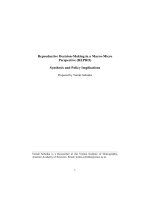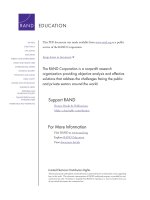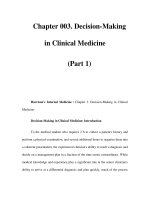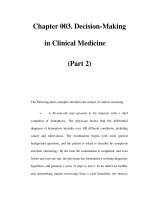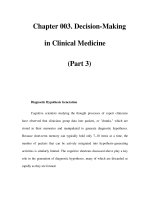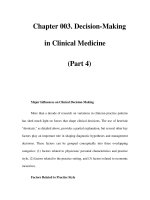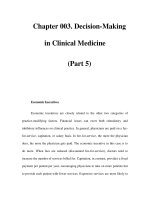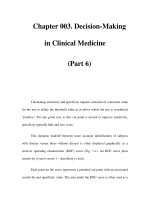Ethical obligations and decision making in accounting text and cases, 4th edition
Bạn đang xem bản rút gọn của tài liệu. Xem và tải ngay bản đầy đủ của tài liệu tại đây (7.49 MB, 625 trang )
Ethical Obligations
and Decision Making
in Accounting
Text and Cases
Fourth Edition
Steven M. Mintz, DBA, CPA
Professor of Accounting
California Polytechnic State University,
San Luis Obispo
Roselyn E. Morris, Ph.D., CPA
Professor of Accounting
Texas State University–San Marcos
ETHICAL OBLIGATIONS AND DECISION MAKING IN ACCOUNTING: TEXT AND CASES,
FOURTH EDITION
Published by McGraw-Hill Education, 2 Penn Plaza, New York, NY 10121. Copyright © 2017 by McGraw-Hill Education. All
rights reserved. Printed in the United States of America. Previous editions © 2014, 2011 and 2008. No part of this publication
may be reproduced or distributed in any form or by any means, or stored in a database or retrieval system, without the prior
written consent of McGraw-Hill Education, including, but not limited to, in any network or other electronic storage or
transmission, or broadcast for distance learning.
Some ancillaries, including electronic and print components, may not be available to customers outside the United States.
This book is printed on acid-free paper.
1 2 3 4 5 6 7 8 9 0 QVS 1 0 9 8 7 6 5 4 3
ISBN 978-1-259-54347-0
MHID 1-259-54347-1
Senior Vice President, Products & Markets: Kurt L. Strand
Vice President, General Manager, Products & Markets: Marty Lange
Vice President, Content Design & Delivery: Kimberly Meriwether David
Managing Director: Tim Vertovec
Senior Brand Manager: Natalie King
Director, Product Development: Rose Koos
Director of Digital Content: Patricia Plumb
Lead Product Developer: Kristine Tibbetts
Senior Product Developer: Rebecca Mann
Marketing Manager: Kyle Burdette
Senior Digital Product Analyst: Xin Lin
Senior Director, Content Design & Delivery: Linda Avenarius
Program Manager: Daryl Horrocks
Content Project Manager: Angela Norris
Buyer: Jennifer Pickel
Designer: Tara McDermott
Content Licensing Specialists: Jacob Sullivan / Melissa Homer
Cover Image: (c) Olaser/Getty Images
Compositor: SPi Global
Typeface: STIX Mathjax Main 10/12
Printer: Quad/Graphics
All credits appearing on pages or at the end of the book are considered to be an extension of the copyright page.
Library of Congress Cataloging-in-Publication Data
Names: Mintz, Steven M., author. | Morris, Roselyn E., author.
Title: Ethical obligations and decision making in accounting : text and cases
/ Steven M. Mintz, DBA, CPA, Professor of Accounting California
Polytechnic State University, San Luis Obispo, Roselyn E. Morris, Ph.D.,
CPA, Professor of Accounting Texas State University-San Marcos.
Description: Fourth Edition. | New York, NY : McGraw-Hill Education, 2016. |
Revised edition of the authors' Ethical obligations and decision making in
accounting, 2014.
Identifiers: LCCN 2015044426 | ISBN 9781259543470 (alk. paper)
Subjects: LCSH: Accountants--Professional ethics--United States--Case
studies.
Classification: LCC HF5616.U5 M535 2016 | DDC 174/.4--dc23 LC record available at
/>The Internet addresses listed in the text were accurate at the time of publication. The inclusion of a Web site does not indicate
an endorsement by the authors or McGraw-Hill Education, and McGraw-Hill Education does not guarantee the accuracy of the
information presented at these sites.
mheducation.com/highered
2013011582
Dedication
“Educating the mind without educating the heart is no education at all.”
Aristotle
What Aristotle meant by this statement is intelligence that is not informed by our hearts--by
compassion--is not really intelligent at all. We strive in this book not only to educate accounting
students to be future leaders in the accounting profession but to stimulate your ethical perception and
cultivate virtue thereby awakening your sense of duty and obligation to the public interest.
About the Authors
Steven M. Mintz, DBA, CPA, is a professor of accounting in the Orfalea
College of Business at the California Polytechnic State University–San
Luis Obsipo. Dr. Mintz received his DBA from George Washington
University. His first book, titled Cases in Accounting Ethics and
Professionalism, was also published by McGraw-Hill. Dr. Mintz has
recently been acknowledged by accounting researchers as one of the top
publishers in accounting ethics and in accounting education. He was
selected for the 2014 Max Block Distinguished Article Award in the
“Technical Analysis” category by The CPA Journal. Dr. Mintz received the
2015 Accounting Exemplar Award of the Public Interest Section of the
American Accounting Association. He also has received the Faculty
Excellence Award of the California Society of CPAs. Dr. Mintz writes two
popular ethics blogs under the names “ethicssage” and “workplaceethicsadvice.”
Roselyn E. Morris, Ph.D., CPA, is a professor of accounting in the
Accounting Department at the McCoy College of Business, Texas State
University–San Marcos. Dr. Morris received her Ph.D. in business
administration from the University of Houston. She is a past president of the
Accounting Education Foundation and chair of the Qualifications Committee
of the Texas Board of Public Accountancy. Dr. Morris has received the
Outstanding Educator Award from the Texas Society of CPAs.
Both Professors Mintz and Morris have developed and teach an accounting
ethics course at their respective universities.
Preface
Ethical Obligations and Decision Making in Accounting was written to guide students through the
minefields of ethical conflict in meeting their responsibilities under the professions’ codes of conduct.
Our book is devoted to helping students cultivate the ethical commitment needed to ensure that their
work meets the highest standards of integrity, independence, and objectivity. An expanded discussion of
professional judgment highlights the challenges to ethical decision-making for internal accountants and
auditors, and external auditors. We hope that this book and classroom instruction will work together to
provide the tools to help students to make ethical judgments and carry through with ethical actions.
The fourth edition of Ethical Obligations and Decision Making in Accounting: Text and
Cases incorporates a behavioral perspective into ethical decision-making that encourages students to get
in touch with their values and learn how to voice them in the workplace when conflicts arise and ethical
dilemmas exist. We build on traditional philosophical reasoning methods by taking the process one step
further, that is, to convert ethical intent into ethical action. The “Giving Voice to Values” (GVV)
approach provides this link. If accounting professionals are successful in voicing values in a way that
encourages doubters and detractors to join the effort, then there may be no need for whistle-blowing.
We also connect many of the issues discussed in the book with a new final chapter on “Ethical
Leadership.”
Several states now require their accounting students to complete an ethics course prior to being licensed
as a CPA. This book has been designed to meet the guidelines for accounting ethics education
including:
encouraging students to make decisions in accordance with prescribed values, attitudes, and
behaviors
providing a framework for ethical reasoning, knowledge of professional values and ethical standards
prescribing attributes for exercising professional skepticism and behavior that is in the best interest
of the investing and consuming public and the profession.
What’s New in the 4th Edition?
In response to feedback and guidance from numerous accounting ethics faculty, the authors have made
many important changes to the fourth edition of Ethical Obligations and Decision Making in
Accounting: Text and Cases, including the following:
Connect is available for the first time with assignable cases, test bank assessment material, and
SmartBook. SmartBook is an excellent way to ensure that students are reading and understanding
the basic concepts in the book and it prepares them to learn from classroom discussions. Several of
the Chapter Cases are available in an auto-graded format to facilitate grading by instructors. The
purpose of using the digital format is to better prepare students ahead of class to free up instructors
to discuss a broader range of topics in their lectures and in the give-and-take between teacher and
student. Connect Insight Reports will also give the instructor a better view into the overall class’s
understanding of core topics prior to class, to appropriately focus lectures and discussion. The
Connect Library also offers materials to support the efforts of first-time and seasoned instructors
of accounting ethics, including a comprehensive Instructor’s Manual, Test Bank, Additional Cases,
and PowerPoint presentations.
Learning Objectives have been added and linked to specific content material in each chapter.
Giving Voice to Values (GVV) approach is explained in Chapter 2 and used throughout the text.
GVV is an innovative pedagogical method that complements the traditional philosophical reasoning
vi
Preface
approaches to ethical decision-making by emphasizing developing the capacity to express one’s
values in a way that positively influences others. The technique is used post-decision-making and is
based on developing and fine-tuning an action plan using scripting and rehearsal. It is ideal for
role-playing exercises.
International auditing and ethics issues are incorporated into existing chapters.
Added five new Discussion Questions to each chapter as well as revised questions with more
current topics and issues.
Replaced many of the cases with more current and topical issues. Eighteen of the 76 cases have
been specifically developed to enable students to practice the “Giving Voice to Values” technique in
the context of the decision-making model.
Expanded the discussion of whistleblowing obligations of accounting professionals in Chapter 3
including guidelines for reporting under Dodd-Frank and the AICPA rules of conduct.
Added a comprehensive section on professional judgment in accounting and auditing to Chapter 4
and models for making judgments and exercising professional skepticism.
Updated Chapter 4 to incorporate the Revised AICPA Code of Professional Conduct.
Expanded the discussion of the PCAOB inspection process in Chapters 5 and 6 for audits of
companies listing stock in the U.S., including Chinese companies and audit deficiencies noted in
inspections of U.S. companies.
Updated case examples used throughout the text to describe earnings management techniques with
expanded coverage in Chapter 7.
New Chapter 8 on “Ethical Leadership” that ties together many of the topics in the chapters in the
text. Ethical leadership is explored in the context of making ethical decisions and judgments in the
performance of professional accounting services.
Improved and expanded the scope of major cases that can be used as an end-of-course project to
enhance the experiences of upper-division undergraduates and graduate students.
Revised and greatly enhanced Instructor’s Resource Materials and supplements.
Chapter 1
New discussion of the use of social networks and social media communications, personal
responsibility, and workplace ethics.
Expanded discussion of moral philosophies and implications for ethical reasoning in accounting and
auditing.
Expanded discussion of the Principles of the AICPA Code of Professional Conduct, the public
interest obligation, and regulation in the accounting profession.
Chapter 2
New discussion of moral intensity and influence on ethical decision making.
New discussion of Kidder’s Ethical Checkpoints and link to moral action.
Expanded discussion of Behavioral Ethics and cognitive development.
New and comprehensive discussion of the GVV technique that provides a mechanism for students to
act on ethical intent. Chapter 2 discusses the foundation of the approach including examples on
applying the methodology. There are five cases in the chapter to engage students in discussions of
the GVV approach to ethical action. Subsequent chapters also contain cases with a GVV dimension.
Preface vii
Chapter 3
New section on “Organizational Ethics and Leadership.”
New discussion of “Character and Leadership in the Workplace.”
Updated results from the National Business Ethics Survey, Association of Certified Fraud
Examiners Global Survey, and KPMG Integrity Survey.
Expanded discussion of financial statement fraud schemes.
New discussion of the morality of whistleblowing.
Added discussion of major whistleblower case of Anthony Menendez v. Halliburton, Inc.
Expanded discussion of Dodd-Frank provisions for whistleblowing by internal accountants and
auditors, and external auditors including when external auditors can blow the whistle on their audit
firms.
Expanded discussion of subordination of judgment rules and their application to whistleblowing.
Chapter 4
Extensive new discussion of professional judgment in accounting.
Added an explanation of KPMG Professional Judgment Framework.
Expanded discussion of professional skepticism.
New discussion of professionalism and commercialism.
Comprehensive discussion of the Revised AICPA Code of Professional Conduct including:
Conceptual Framework for Members in Public Practice and Conceptual Framework for Members in
Business.
New discussion of ethical conflict requirements and decision-making model under the Revised
Code.
Expanded discussion of AICPA Conceptual Framework for Independence Standards.
Expanded discussion of integrity and subordination of judgment rules.
New discussion of confidentiality and disclosing fraud.
Expanded discussion of ethics in tax practice.
Expanded discussion of “Insider Trading” cases against CPAs.
New discussion of Global Code of Ethics.
Chapter 5
Expanded discussion of errors, illegal acts, and fraud.
New discussion of Private Securities Litigation Reform Act and reporting requirements to the SEC;
fraud and confidentiality issues explored.
Discussion of Professional Skepticism Scale that measures traits conducive to developing a
questioning mind and informed judgment.
Discussion of findings of the Center for Audit Quality of audit deficiencies.
Expanded discussion of PCAOB audit inspection process and high rate of deficiencies of audit
firms.
viii
Preface
Chapter 6
New cases that explore in depth legal obligations of accountants and auditors.
Expanded discussion of auditor legal liabilities.
Expanded section on legal liabilities under Sarbanes-Oxley.
New discussion of International Financial Reporting Standards and international enforcement.
New discussion of principles versus rules-based standards and SEC position on objectives-oriented
standards.
New section on “Compliance and Management by Values.”
New section on “Global Ethics, Fraud, and Bribery” and the Foreign Corrupt Practices Act.
Expanded discussion on regulatory issues and PCAOB inspections.
Chapter 7
New section on “Non-Financial Measures of Earnings.”
Expanded discussion of earnings management and professional judgment.
Expanded discussion of the use of accruals and earnings management.
Introductory discussion of new revenue recognition standard.
Detailed examples of financial statement restatements of Hertz Corporation and Cubic Corporation,
and CVS-Caremark merger.
Chapter 8 – New Chapter on Ethical Leadership
Chapter 8 links back to discussions in Chapters 1 through 7 by incorporating material on “Ethical
Leadership.” The purpose is to leave students with a positive message of the importance of being a
leader and ethical leadership in building organizational ethics. Leadership in decision-making in
accounting, auditing, tax, and advisory services engagements is addressed. The chapter includes 20
discussion questions and 6 new cases. The chapter includes the following major topics:
Discussion of moral decision-making and leadership.
Exploring different types of leaders: authentic leaders, transformational leadership, followership and
leadership, and how social learning theory influences leadership.
Revisiting moral intensity in the context of ethical leadership.
Ethical leadership and internal audit function.
Ethical leadership and tax practice.
Gender influences in leadership.
Causes of leadership failures.
Case studies on ethical leadership.
Implications of ethical leadership for whistleblowing activities.
Values-based leadership.
Ethical leadership and the GVV technique.
Ethical leadership competence.
®
Required=Results
McGraw-Hill Connect®
Learn Without Limits
Connect is a teaching and learning platform
that is proven to deliver better results for
students and instructors.
Connect empowers students by continually
adapting to deliver precisely what they need,
when they need it, and how they need it,
so your class time is more engaging and
effective.
88% of instructors who use Connect
require it; instructor satisfaction increases
by 38% when Connect is required.
Using Connect improves passing rates
by 10.8% and retention by 16.4%.
Analytics
Connect Insight®
Connect Insight is Connect’s new one-of-a-kind
visual analytics dashboard—now available for both
instructors and students—that provides at-a-glance
information regarding student performance, which is immediately
actionable. By presenting assignment, assessment, and topical
performance results together with a time metric that is easily
visible for aggregate or individual results, Connect Insight gives the
user the ability to take a just-in-time approach to teaching and
learning, which was never before available. Connect Insight presents
data that empower students and help instructors improve class
performance in a way that is efficient and effective.
Students can view
their results for any
Connect course.
Adaptive
THE FIRST AND ONLY
ADAPTIVE READING
EXPERIENCE DESIGNED
TO TRANSFORM THE
WAY STUDENTS READ
More students earn A’s and
B’s when they use McGraw-Hill
Education Adaptive products.
SmartBook®
Proven to help students improve grades and
study more efficiently, SmartBook contains the
same content within the print book, but actively
tailors that content to the needs of the individual.
SmartBook’s adaptive technology provides
precise, personalized instruction on what the
student should do next, guiding the student to
master and remember key concepts, targeting
gaps in knowledge and offering customized
feedback, and driving the student toward
comprehension and retention of the subject
matter. Available on smartphones and tablets,
SmartBook puts learning at the student’s
fingertips—anywhere, anytime.
Over 4 billion questions have been
answered, making McGraw-Hill
Education products more intelligent,
reliable, and precise.
www.learnsmartadvantage.com
Preface
Acknowledgments
The authors want to express their sincere gratitude to these reviewers for their comments and guidance.
Their insights were invaluable in developing this edition of the book.
Donald Ariail, Southern Polytechnic State University
Stephanie Bacik, Wake Tech Community College
Charles Bunn, Jr., Wake Tech Community College
Kevin Cabe, Indiana Wesleyan University
Rick Crosser, Metropolitan State University of Denver
Denise Dickins, East Carolina University
Dennis L. Elam, Texas A&M University–San Antonio
Rafik Elias, California State University–Los Angeles
Athena Jones, University of Maryland University College
Patrick Kelly, Providence College
Lorraine S. Lee, University of North Carolina–Wilmington
Stephen McNett, Texas A&M University–Central Texas
Kenneth Merchant, University of Southern California
Michael Newman, University of Houston
Robin Radtke, Clemson University
John Sennetti, NOVA Southeastern University
Edward Smith, St. John’s University
Dale Wallis, University of California–Los Angeles Extension
We also appreciate the assistance and guidance given us on this project by the staff of McGraw-Hill
Education, including Tim Vertovec, managing director; Natalie King, senior brand manager; Kyle
Burdette, marketing manager; Rebecca Mann, senior product developer; Daryl Horrocks, program
manager; Angela Norris, content project manager; Jacob Sullivan and Melissa Homer, content licensing
specialists; and Jennifer Pickel, buyer. We greatly appreciate the efforts of Deborah Pfeiffer, copyeditor
of the book.
Finally, we would like to acknowledge the contributions of our students, who have provided invaluable
comments and suggestions on the content and use of these cases.
If you have any questions, comments, or suggestions concerning Ethical Obligations and Decision
Making in Accounting, please send them to Steve Mintz at
xi
Case # Case Name/Description
1-1
1-2
Harvard Cheating Scandal
Student cheating at Harvard raises questions about responsibilities of instructors and student personal
responsibilities
Giles and Regas
Dating relationship between employees of a CPA firm jeopardizes completion of the audit.
1-3
NYC Subway Death: Bystander Effect or Moral Blindness
Real-life situation where onlookers did nothing while a man was pushed to his death off a subway platform.
1-4
Lone Star School District
Failure to produce documents to support travel expenditures raises questions about the justifiability of
reimbursement claims.
Reneging on a Promise
Ethical dilemma of a student who receives an offer of employment from a firm that he wants to work for, but
only after accepting an offer from another firm.
1-5
1-6
Capitalization versus Expensing
Ethical obligations of a controller when pressured by the CFO to capitalize costs that should be expensed.
1-7
Eating Time
Ethical considerations of a new auditor who is asked to cut down on the amount of time that he takes to
complete audit work.
1-8
Shifty Industries
Depreciation calculations and cash outflow considerations in a tax engagement.
1-9
Cleveland Custom Cabinets
Ethical and professional responsibilities of an accountant who is asked to “tweak” overhead to improve
reported earnings.
1-10
Better Boston Beans
Conflict between wanting to do the right thing and a confidentiality obligation to a coworker.
Case #
Case Name/Description
2-1
A Team Player (a GVV case)
Ethical dilemma for audit staff member who discovers a deficiency in inventory procedures but is unable to
convince the group to report it. Application of Giving Voice to Values approach.
2-2
FDA Liability Concerns (a GVV case)
Conflict between a chef and CFO over reporting bacteria found in food and FDA inspection results.
Application of GVV approach.
2-3
The Tax Return (a GVV case)
Tax accountant’s ethical dilemma when asked by her supervisor to ignore reportable lottery winnings.
Application of GVV approach.
2-4
A Faulty Budget (a GVV case)
Ethical and professional responsibilities of an accountant after discovering an error in his sales budget.
Application of GVV approach.
2-5
Gateway Hospital (a GVV case)
Behavioral ethics considerations in developing a position on unsubstantiated expense reimbursement claims.
Application of GVV approach.
2-6
LinkedIn and Shut Out
Small business owner’s inability to gain support from LinkedIn after a contact in his professional network
scams him out of $30,000.
2-7
Milton Manufacturing Company
Dilemma for top management on how best to deal with a plant manager who violated company policy but at
the same time saved it $1.5 million.
Case Descriptions
2-8
Juggyfroot
Pressure imposed by a CEO on external accountants to change financial statement classification of
investments in securities to defer reporting a market loss in earnings.
2-9
Phar-Mor
SEC investigation of Phar-Mor for overstating inventory and misuse of corporate funds by the COO.
2-10
WorldCom
Persistence of internal auditor, Cynthia Cooper, to correct accounting fraud and implications for Betty
Vinson, a midlevel accountant, who went along with the fraud.
Case #
Case Name/Description
3-1
The Parable of the Sadhu
Classic Harvard case about ethical dissonance and the disconnect between individual and group ethics.
3-2
Rite Aid Inventory Surplus Fraud
Dilemma of director of internal auditing whether to blow the whistle under Dodd-Frank on Rite Aid’s
inventory surplus sales/kickback scheme.
3-3
United Thermostatic Controls (a GVV case)
Acceptability of accelerating the recording of revenue to meet financial analysts’ earnings estimates and
increase bonus payments.
3-4
Franklin Industries’ Whistleblowing (a GVV case)
Considerations of internal accountant how best to voice her values to convince others to act on questionable
payments to a related-party entity.
3-5
Walmart Inventory Shrinkage (a GVV case)
Pressure to reduce inventory shrinkage at a Walmart store amidst alleged accounting improprieties and
related efforts of the protagonist to voice values.
3-6
Bennie and the Jets (a GVV case)
Ethical and professional obligations in reporting accounting wrongdoing to higher-ups in the organization.
3-7
Olympus
Major corporate scandal in Japan where Olympus committed a $1.7 billion fraud involving concealment of
investment losses through fraudulent accounting.
3-8
Accountant takes on Halliburton and Wins!
Violation of confidentiality provision in a whistleblowing case under SOX after Bob Menendez reported
retaliation by Halliburton subsequent to informing the audit committee of improper revenue recognition
policies using bill-and-hold transactions.
3-9
Bhopal, India: A Tragedy of Massive Proportions
Evaluation of the decision-making process before, during, and after the leak of a toxic chemical that killed or
injured thousands.
3-10
Accountability of Ex-HP CEO in Conflict of Interest Charges
Sexual harassment charges stemming from conflict of interest between CEO/board chair and outside
contractor.
Case #
Case Name/Description
4-1
KBC Solutions
Concerns about professional judgments made by audit senior after the review of workpaper files.
4-2
Beauda Medical Center
Confidentiality obligation of an auditor to a client after discovering a defect in a product that may be
purchased by a second client.
4-3
Family Games, Inc.
Ethical dilemma for a controller being asked to backdate a revenue transaction to increase performance
bonuses in order to cover the CEO’s personal losses.
xiii
xiv
Case Descriptions
4-4
Commercialism and Professionalism (a GVV case)
Ethical considerations in an alternative practice structure due to threats to independence; using GVV to
resolve conflict.
4-5
Han, Kang & Lee, LLC
Pressure between audit partner who wants the client to write down inventory and other partners that want to
keep the client happy.
4-6
Tax Shelters
Ethical dilemma of tax accountant in deciding whether to participate in tax shelter transactions targeted to
top management of a client entity in light of cultural influences within the firm.
4-7
M&A Transaction
Ethical issues concerning a decision to provide merger and acquisition advisory services for an audit client.
4-8
Valley View Hospital
Ethical obligations of CPA in deciding whether to report a hospital/client for improper Medicare payments to
the government because of a faulty Medicare accounting system.
4-9
AOL-Time Warner
Fall out after CFO of AOL blows the whistle on improper round-trip accounting procedures in AOL-Time
Warner merger and is investigated himself for his part in the fraud by the SEC.
4-10
Navistar International
Confidentiality issues that arise when Navistar management questions the competency of Deloitte & Touche
auditors by referring to PCAOB inspection reports and fraud at the company.
Case #
Case Name/Description
5-1
Loyalty and Fraud Reporting (a GVV case)
Employee who embezzles $50,000 seeks out the help of a friend to cover it up. Application of the fraud
triangle and GVV.
5-2
ZZZZ Best
Fraudster Barry Minkow uses fictitious revenue transactions from nonexistent business to falsify financial
statements.
5-3
Imperial Valley Community Bank
Role of professional skepticism in evaluating audit evidence on collectability of loans and going concern
assessment.
5-4
Busy Season Planning
Role of review partner in planning an audit.
5-5
Tax Inversion
Questions about the use of IFRS in a consolidation with an Irish entity motivated by tax inversion benefits.
5-6
Rooster, Hen, Footer, and Burger
Ethical obligations of a CPA following the discovery of an unreported related party transaction and push
back by client entity.
5-7
Diamond Foods: Accounting for Nuts
Application of the fraud triangle to assess corporate culture and analysis of fraud detection procedures.
5-8
Bill Young’s Ethical Dilemma
Options of a friend of an auditor advising the auditor following his inappropriate downloading of client
information that shows bribery of foreign officials.
5-9
Royal Ahold N.V. (Ahold)
U.S. subsidiary of a Dutch company that used improper accounting for promotional allowances to meet or
exceed budgeted earnings targets and questions about professional judgment by auditors.
5-10
Groupon
Competitive pressures on social media pioneer leads to internal control weakness and financial restatements.
Case Descriptions xv
Case #
Case Name/Description
6-1
Advanced Battery Technologies: Reverse Merger
Application of legal standards to assess auditor liability following a reverse merger transaction by a Chinese
company.
6-2
Heinrich Müller: Big Four Whistleblower? (a GVV case)
Ethical dilemma of tax accountant after finding confidential files of a client engaged in tax avoidance
transactions in Liechtenstein in view of a culture of strict loyalty to the firm.
6-3
Richards & Co: Year-end Audit Engagement
Questions about audit procedures used to assess client’s improper use of a credit received from a client to
prop up revenue in one year while agreeing to repay the supplier in the following year.
6-4
Anjoorian et al.: Third-Party Liability
Application of the foreseeability test, near-privity, and the Restatement approach in deciding negligence
claims against the auditor.
6-5
Vertical Pharmaceuticals Inc. et al. v. Deloitte & Touche LLP
Fiduciary duties and audit withdrawal considerations when suspecting fraud at a client.
6-6
Kay & Lee LLP
Auditor legal liability when foreseen third party relies on financial statement.
6-7
Getaway Cruise Lines: Questionable Payments to do Business Overseas (a GVV case)
Ethical dilemma of Director of International Accounting in voicing her values with respect to a dispute
within the company over how to report “questionable payments” made to a foreign government.
6-8
Con-way Inc.
Auditor legal and audit responsibilities to assess facilitating payments and internal control requirements
under the FCPA.
6-9
Satyam: India’s Enron
Questions about corporate culture and fraud risk assessment surrounding CEO’s falsification of financial
information and misuse of corporate funds for personal purposes.
6-10
Autonomy
Investigations by U.S. SEC and UK Serious Fraud Office into accounting for an acquisition of a British
software maker by Hewlett-Packard (HP).
Case #
Case Name/Description
7-1
Nortel Networks
Use of reserves and revenue recognition techniques to manage earnings.
7-2
Solutions Network, Inc. (a GVV case)
Ethical challenges of a controller in voicing values when the company uses round-trip transactions to meet
earnings targets.
7-3
GE: “Imagination at Work”
Assessing whether GE used earnings management techniques to accelerate revenue and meet financial
analysts’ earnings expectations.
7-4
Harrison Industries (a GVV case)
Challenges faced by first-year accountant in voicing values upon questioning the appropriateness of
recording an accrued expense.
7-5
Dell Computer
Use of “cookie-jar” reserves to smooth net income and meet financial analysts’ earnings projections.
7-6
Tier One Bank
Failure of KPMG to exercise due care and proper professional judgment in gathering supporting evidence
for loan loss estimates.
7-7
Sunbeam Corporation
Use of cookie-jar reserves and “channel stuffing” by a turnaround artist to manage earnings.
xvi
Case Descriptions
7-8
Sino-Forest: Accounting for Trees
Failure of Ernst & Young to follow generally accepted auditing standards and lapses in professional ethics
related to Chinese company’s nonexistent forestry assets; cultural considerations of doing business in China.
7-9
The North Face, Inc.
Questions about revenue recognition on barter transactions and the role of Deloitte & Touche in its audit of the client.
7-10
Beazer Homes
Use of cookie jar reserves to manage earnings and meet EBIT targets.
Case #
Case Name/Description
8-1
Research Triangle Software Innovations (a GVV case)
Advisory services staff member recommends the software package of an audit client to another client and
deals with push back from her supervisor who is pushing the firm’s package; issues related to leadership and
application of GVV in resolving the matter.
8-2
Cumberland Lumber
Difference of opinion between chief internal auditor and aggressive CFO about recording year-end accruals.
8-3
Parmalat: Europe’s Enron
Fictitious accounts at Bank of America and the use of nominee entities to transfer debt off the books by an
Italian company led to one of Europe’s largest fraud cases.
8-4
KPMG Tax Shelter Scandal
Major tax shelter scandal case involving KPMG that explores ethical standards in tax practice and in
developing tax positions on tax shelter products in a culture that promoted making sales at all costs.
8-5
Krispy Kreme Doughnuts, Inc.
Questions about ethical leadership and corporate governance at Krispy Kreme, and audit by PwC, with
respect to the company’s use of round-trip transactions to inflate revenues and earnings to meet or exceed
financial analysts’ EPS guidance.
8-6
Rhody Electronics: A Difficult Client (a GVV case)
Conflict between audit manager and controller over audit planning and execution and implications for
ethical leadership.
Major Cases
Case #
Case Name/Description
1
Adelphia Communications Corporation
SEC action against Deloitte & Touche for failing to exercise the proper degree of professional skepticism
in examining complex related-party transactions and contingencies that were not accounted for in
accordance with GAAP.
2
Royal Ahold N.V. (Ahold)
Court finding that Deloitte & Touche should not be held liable for the efforts of the client to deprive the
auditors of accurate information needed for the audit and masking the true nature of other evidence.
3
Madison Gilmore’s Ethical Dilemma (a GVV case)
Distinguishing between operational and accounting earnings management and efforts of controller to
voice values and convince the CFO about inappropriateness of recoding revenue on a bill-and-hold transaction.
4
Cendant Corporation
SEC action against Cendant for managing earnings through merger reserve manipulations and improper
accounting for membership sales, and questions about the audit of Ernst & Young.
5
Vivendi Universal
Improper adjustments to EBITDA and operating free cash flow by a French multinational company to
meet ambitious earnings targets and conceal liquidity problems.
6
Waste Management
Failure of Andersen auditors to enforce agreement with the board of directors to adopt proposed adjusting
journal entries that were required in restated financial statements.
Brief Contents
1
Ethical Reasoning: Implications for
Accounting 1
6
Legal, Regulatory, and Professional
Obligations of Auditors 339
2
Cognitive Processes and Ethical Decision
Making in Accounting 61
7
Earnings Management
3
Organizational Ethics and Corporate
Governance 111
8
Ethical Leadership and
Decision-Making in Accounting
4
Ethics and Professional Judgment in
Accounting 201
MAJOR CASES
5
Fraud in Financial Statements
and Auditor Responsibilities 269
INDEXES
IN-1
547
405
503
Table of Contents
Chapter 1
Ethical Reasoning: Implications for
Accounting 1
Ethics Reflection 2
Integrity: The Basis of Accounting 4
Religious and Philosophical Foundations of Ethics 5
What Is Ethics? 7
Difference between Ethics and Morals 7
Norms, Values, and the Law 8
Ethical Relativism 9
Situation Ethics 10
Social Networkers and Workplace Ethics 13
Cultural Values 14
The Six Pillars of Character 15
Trustworthiness 16
Respect 18
Responsibility 18
Fairness 19
Caring 19
Citizenship 20
Expectations of Millennials 20
Reputation 21
Civility, Ethics, and Workplace Behavior 22
Modern Moral Philosophies 24
Teleology 25
Deontology 28
Justice 30
Virtue Ethics 32
The Public Interest in Accounting 33
Regulation of the Accounting Profession 34
AICPA Code of Conduct 35
Virtue, Character, and CPA Obligations 36
Application of Ethical Reasoning in Accounting 37
DigitPrint Case Study 37
Scope and Organization of the Text 41
Concluding Thoughts 42
Discussion Questions 43
Endnotes 46
Chapter 1 Cases 51
Case 1-1: Harvard Cheating Scandal 51
Case 1-2: Giles and Regas 52
Case 1-3: NYC Subway Death: Bystander Effect or
Moral Blindness 53
Case 1-4: Lone Star School District 54
Case 1-5: Reneging on a Promise 55
Case 1-6: Capitalization versus Expensing 55
Case 1-7: Eating Time 56
Case 1-8: Shifty Industries 56
Case 1-9: Cleveland Custom Cabinets 57
Case 1-10: Better Boston Beans 58
Chapter 2
Cognitive Processes and Ethical Decision
Making in Accounting 61
Ethics Reflection 62
Kohlberg and the Cognitive Development
Approach 63
Heinz and the Drug 63
Universal Sequence 67
The Ethical Domain in Accounting and Auditing 67
Moral Reasoning and Moral Behavior 68
Rest’s Four-Component Model of Ethical Decision
Making 69
Moral Sensitivity 70
Moral Judgment 70
Moral Motivation 71
Moral Character 71
Moral Intensity 72
Aligning Ethical Behavior and Ethical Intent: VirtueBased Decision Making 73
Ethical Decision-Making Models 74
Kidder’s Ethical Checkpoints 75
Integrated Ethical Decision-Making Process 77
Application of the Integrated Ethical Decision-Making
Model: Ace Manufacturing 77
Behavioral Ethics 80
Giving Voice to Values 82
Reasons and Rationalizations 83
Basic Exercise in GVV 83
Ace Manufacturing: GVV Analysis 85
Concluding Thoughts 87
Discussion Questions 88
Endnotes 92
Chapter 2 Cases 96
Case 2-1: A Team Player? (a GVV case) 96
Case 2-2: FDA Liability Concerns (a GVV case) 96
Case 2-3: The Tax Return (a GVV case) 98
Case 2-4: A Faulty Budget (a GVV case) 99
Case 2-5: Gateway Hospital (a GVV case) 100
Case 2-6: LinkedIn and Shut Out 101
Case 2-7: Milton Manufacturing Company 102
Case 2-8: Juggyfroot 105
Case 2-9: Phar-Mor 106
Case 2-10: WorldCom 108
Table of Contents xix
Chapter 3
Organization Ethics and Corporate
Governance 111
Ethics Reflection 112
Organizational Ethics and Leadership 114
Ethical Issue Intensity 114
Individual Factors 115
Organizational Factors 115
Opportunity 115
Business Ethics Evaluations and Intentions 115
Ethical or Unethical Behavior 116
Organization Influences on Ethical Decision
Making 116
Ethical Dissonance Model 117
Seven Signs of Ethical Collapse 118
Pressure to Maintain the Numbers 119
Fear of Reprisals 119
Loyalty to the Boss 119
Weak Board of Directors 120
Stakeholder Orientation 120
The Case of the Ford Pinto 121
Establishing an Ethical Culture 123
Trust in Business 124
Johnson & Johnson: Trust Gained 124
Johnson & Johnson: Trust Deficit 125
Ethics in the Workplace 127
Character and Leadership in the Workplace 128
Integrity: The Basis for Trust in the Workplace 128
Employees Perceptions of Ethics in the Workplace 129
Fraud in Organizations 130
Occupational Fraud 130
Internal Control Weaknesses 134
Financial Statement Fraud 135
Foundations of Corporate Governance Systems 139
Defining Corporate Governance 139
Views of Corporate Governance 140
Corporate Governance Regulation 141
Executive Compensation 142
Corporate Governance Structures and
Relationships 145
Ethical and Legal Responsibilities of Officers and
Directors 145
Honest Services Fraud 146
Relationships between Audit Committee, Internal
Auditors, and External Auditors 147
Internal Controls as a Monitoring Device 149
Compliance Function 152
Has SOX Accomplished Its Intended Goal? 152
Whistleblowing 154
Morality of Whistleblowing 154
Rights and Duties 155
Obligation to Report Fraud 157
Dodd-Frank Provisions 158
The Morality of Whistleblowing 161
Whistleblowing Experiences 161
Concluding Thoughts 162
Discussion Questions 163
Endnotes 166
Chapter 3 Cases 171
Case 3-1: The Parable of the Sadhu 171
Case 3-2: Rite Aid Inventory Surplus Fraud 175
Case 3-3: United Thermostatic Controls (a GVV
case) 176
Case 3-4: Franklin Industries’ Whistleblowing (a GVV
Case) 180
Case 3-5: Walmart Inventory Shrinkage (a GVV
Case) 181
Case 3-6: Bennie and the Jets (a GVV Case) 182
Case 3-7: Olympus 183
Case 3-8: Accountant takes on Halliburton and
Wins! 188
Case 3-9: Bhopal, India: A Tragedy of Massive
Proportions 192
Case 3-10: Accountability of Ex-HP CEO in Conflict of
Interest Charges 199
Chapter 4
Ethics and Professional Judgment in
Accounting 201
Ethics Reflection 202
What is Professional Judgment in Accounting? 204
Link between Attitudes, Behaviors, and Judgment 204
KPMG Professional Judgment Framework 204
Link between KPMG Framework and Cognitive
Processes 205
Role of Professional Skepticism 206
The Public Interest in Accounting 207
Professionalism versus Commercialism 208
Investigations of the Profession: Where Were the
Auditors? 209
Metcalf Committee and Cohen Commission:
1977–1978 209
House Subcommittee on Oversight and Investigations:
1986 210
Savings and Loan Industry Failures: Late 1980s–Early
1990s 211
Treadway Commission Report 211
The Role of the Accounting Profession in the
Financial Crisis of 2007–2008 212
xx Table of Contents
AICPA Code: Independence Considerations for
Members in Public Practice 214
Introduction to Revised Code 214
Members in Public Practice 215
Conceptual Framework for AICPA Independence
Standards 215
Safeguards to Counteract Threats 217
Global Code of Ethics 218
Relationships That May Impair Independence 218
SEC Position on Auditor Independence 221
SEC Actions Against Big Four CPA Firms 222
Insider Trading Cases 224
“Operation Broken Gate” 225
AICPA Code: Ethical Conflicts 226
Integrity and Objectivity 226
Conflicts of Interest 227
Subordination of Judgment 229
AICPA Code: Conceptual Framework for Members in
Business 231
Threats and Safeguards 231
Ethical Conflicts 232
Integrity and Objectivity/Conflicts of Interest 233
Subordination of Judgment 234
Link between Conceptual Framework and Giving Voice
to Values 234
SOX: Nonaudit Services 235
Rules of Professional Practice 236
General Standards Rule (1.300.001) 236
Acts Discreditable (1.400.001) 237
Contingent Fees (1.510.001) 240
Commissions and Referral Fees (1.520.001) 241
Advertising and Other Forms of Solicitation
(1.600.001) 241
Confidential Information (1.700.001) 242
Form of Organization and Name (1.800.001) 244
Commercialism and the Accounting Profession 244
Ethics and Tax Services 245
Statements on Standards for Tax Services (SSTS) 245
Tax Shelters 247
PCAOB Rules 250
Rule 3520—Auditor Independence 250
Rule 3521—Contingent Fees 250
Rule 3522—Tax Transactions 250
Rule 3523—Tax Services for Persons in Financial
Reporting Oversight Roles 250
Rule 3524—Audit Committee Preapproval of Certain Tax
Services 251
Rule 3525—Audit Committee Preapproval of
Nonauditing Services Related to Internal Control over
Financial Reporting 251
Rule 3526—Communication with Audit Committees
Concerning Independence 251
Concluding Thoughts 252
Discussion Questions 253
Endnotes 256
Chapter 4 Cases 258
Case 4-1: KBC Solutions 258
Case 4-2: Beauda Medical Center 259
Case 4-3: Family Games, Inc. 260
Case 4-4: Commercialism versus Professionalism (a
GVV case) 261
Case 4-5: Han, Kang & Lee, LLC 262
Case 4-6: Tax Shelters 262
Case 4-7: M&A Transaction 263
Case 4-8: Valley View Hospital 264
Case 4-9: AOL-Time Warner 265
Case 4-10: Navistar International 266
Chapter 5
Fraud in Financial Statements and Auditor
Responsibilities 269
Ethics Reflection 270
Fraud in Financial Statements 271
Nature and Causes of Misstatements 272
Errors, Fraud, and Illegal Acts 272
Reporting Fraud/Illegal Acts 274
The Fraud Triangle 276
Incentives/Pressures to Commit Fraud 277
Opportunity to Commit Fraud 277
Rationalization for the Fraud 278
Tyco Fraud 280
Fraud Considerations and Risk Assessment 282
Fraud Risk Assessment 282
Internal Control Assessment 282
Enterprise Risk Management—Integrated
Framework 283
Audit Committee Responsibilities for Fraud Risk
Assessment 285
Auditor’s Communication with Those Charged with
Governance 285
Management Representations and Financial Statement
Certifications 286
Audit Report and Auditing Standards 287
Background 287
Audit Report 287
Audit Opinions 290
Limitations of the Audit Report 292
Generally Accepted Auditing Standards (GAAS) 295
Professional Skepticism 297
Table of Contents xxi
PCAOB Standards and Inspections 299
PCAOB Standards 299
Audit Deficiencies—SEC Actions 305
PCAOB Inspections Program 305
Concluding Thoughts 308
Discussion Questions 309
Endnotes 312
Chapter 5 Cases 314
Case 5-1: Loyalty and Fraud Reporting (a GVV
case) 314
Case 5-2: ZZZZ Best 315
Case 5-3: Imperial Valley Community Bank 319
Case 5-4: Busy Season Planning 326
Case 5-5: Tax Inversion (a GVV case) 327
Case 5-6: Rooster, Hen, Footer, and Burger 328
Case 5-7: Diamond Foods: Accounting for Nuts 329
Case 5-8: Bill Young’s Ethical Dilemma 330
Case 5-9: Royal Ahold N.V. (Ahold) 331
Case 5-10: Groupon 334
Chapter 6
Legal, Regulatory, and Professional
Obligations of Auditors 339
Ethics Reflection 340
Legal Liability of Auditors: An Overview 341
Common-Law Liability 342
Liability to Clients—Privity Relationship 343
Liability to Third Parties 344
Actually Foreseen Third Parties 344
Reasonably Foreseeable Third Parties 345
Auditor Liability to Third Parties 348
Statutory Liability 350
Securities Act of 1933 351
Key Court Decisions 352
Securities Exchange Act of 1934 353
Court Decisions and Auditing Procedures 355
Private Securities Litigation Reform Act
(PSLRA) 358
Proportionate Liability 358
“Particularity” Standard 359
SOX and Auditor Legal Liabilities 361
Section 404. Internal Control over Financial
Reporting 361
Section 302. Corporate Responsibility for Financial
Reports 362
Perspective on Accomplishments of SOX 363
Foreign Corrupt Practices Act (FCPA) 363
Regulatory and Professional Issues: An International
Perspective 368
Restoring the Public Trust 368
International Financial Reporting 368
Principles- versus Rules-Based Standards 370
Compliance and Ethical Issues 372
Global Ethics, Fraud, and Bribery 372
Global Ethics 372
Global Fraud 373
Global Bribery 373
PCAOB Inspections of Chinese Companies 375
Concluding Thoughts 376
Discussion Questions 376
Endnotes 379
Chapter 6 Cases 384
Case 6-1: Advanced Battery Technologies: Reverse
Merger 384
Case 6-2: Heinrich Müller: Big Four Whistleblower? (a
GVV case) 385
Case 6-3: Richards & Co: Year-end Audit
Engagement 387
Case 6-4: Anjoorian et al.: Third-Party Liability 388
Case 6-5: Vertical Pharmaceuticals Inc. et al. v. Deloitte
& Touche LLP 391
Case 6-6: Kay & Lee, LLP 392
Case 6-7: Getaway Cruise Lines: Questionable Payments
to do Business Overseas (a GVV case) 392
Case 6-8: Con-way Inc. 395
Case 6-9: Satyam: India’s Enron 397
Case 6-10: Autonomy 400
Chapter 7
Earnings Management 405
Ethics Reflection 406
Motivation for Earnings Management 408
Earnings Guidance 408
Nonfinancial Measures of Earnings 413
Income Smoothing 414
Characteristics of Earnings Management 416
Definition of Earnings Management 416
Ethics of Earnings Management 417
How Managers and Accountants Perceive Earnings
Management 418
Earnings Quality 420
Accruals and Earnings Management 421
Earnings Management Judgments 422
Acceptability of Earnings Management from a
Materiality Perspective 422
Earnings Management Techniques 427
CVS Caremark Acquisition of Longs Drugstores 428
Definition of “Revenue Recognition” 433
xxii Table of Contents
New Revenue Recognition Standard 434
Earnings Management: One More Thing 435
Financial Shenanigans 436
Financial Statement Effects 436
Red Flags of Earnings Management 439
Examples of Shenanigans 440
Financial Statement Restatements 452
Characteristics of Restatements 452
Hertz Accounting Restatements 453
Restatements Due to Errors in Accounting and
Reporting 456
Concluding Thoughts 458
Discussion Questions 459
Endnotes 462
Chapter 7 Cases 468
Case 7-1: Nortel Networks 468
Case 7-2: Solutions Network, Inc. (a GVV case) 473
Case 7-3: GE: “Imagination at Work” 475
Case 7-4: Harrison Industries (a GVV case) 477
Case 7-5: Dell Computer 478
Case 7-6: TierOne Bank 481
Case 7-7: Sunbeam Corporation 483
Case 7-8: Sino-Forest: Accounting for Trees 488
Case 7-9: The North Face, Inc. 492
Case 7-10: Beazer Homes 496
Chapter 8
Ethical Leadership and Decision-Making in
Accounting 503
Ethics Reflection 504
What Is Ethical Leadership? 506
Moral Person and Moral Manager 507
Authentic Leaders 508
Transformational Leadership 509
Followership and Leadership 509
Social Learning Theory 510
Moral Intensity 511
The Role of Moral Intensity, Organizational Culture,
and Ethical Leadership in Accounting 511
Ethical Leadership and Audit Firms 512
Gender Influence on Decision Making of Public
Accounting Professionals 513
Ethical Leadership and the Internal Audit Function 514
Ethical Leadership and Tax Practice 515
The Role of CFOs 516
Ethical Leadership Failure 517
Implications for Whistleblowing in Accounting 518
A Case Study in Ethical Leadership 520
Accounting Leaders Discussed in the Text 522
Values-Driven Leadership 522
Ethical Leadership Competence 524
Concluding Thoughts 525
Discussion Questions 526
Endnotes 527
Chapter 8 Cases 531
Case 8-1: Research Triangle Software Innovations (a
GVV case) 531
Case 8-2: Cumberland Lumber 532
Case 8-3: Parmalat: Europe’s Enron 533
Case 8-4: KPMG Tax Shelter Scandal 539
Case 8-5: Krispy Kreme Doughnuts, Inc 541
Case 8-6: Rhody Electronics: A Difficult Client (a GVV
case) 544
Major Cases 547
Major Case 1: Adelphia Communications
Corporation 548
Major Case 2: Royal Ahold N.V. (Ahold) 558
Major Case 3: Madison Gilmore’s Ethical Dilemma (a
GVV Case) 566
Major Case 4: Cendant Corporation 567
Major Case 5: Vivendi Universal 576
Major Case 6: Waste Management 579
Chapter
1
Ethical Reasoning:
Implications for
Accounting
Learning Objectives
After studying Chapter 1, you should be able to:
LO 1-1
LO 1-2
LO 1-3
LO 1-4
LO 1-5
LO 1-6
LO 1-7
Explain how integrity enables a CPA to withstand pressures and avoid
subordination of judgment.
Discuss the relationship between one’s values and ethics, and legal
obligations.
Describe how the pillars of character support ethical decision making.
Differentiate between moral philosophies and their effect on ethical
reasoning in accounting.
Explain the concept of the public interest in accounting.
Discuss the Principles section of the AICPA Code of Professional Conduct.
Apply the IMA Statement of Ethical and Professional Practice to a case
study.
1
2
Chapter 1
Ethical Reasoning: Implications for Accounting
Ethics Reflection
Penn State Child Abuse Scandal: A Culture of Indifference
What motivates an otherwise ethical person to do the wrong thing when faced with an
ethical dilemma? Why does a good person act wrongly in a particular situation? These
are the ethical questions that arise from the Penn State scandal. Football head coach
Joe Paterno and administrators at Penn State University looked the other way and
failed to act on irrefutable evidence that former assistant coach Jerry Sandusky had
molested young boys, an offense for which Sandusky currently is serving a 30- to
60-year sentence. According to the independent report by Louis Freeh that
investigated the sexual abuse, the top administrators at Penn State and Joe Paterno
sheltered a child predator harming children for over a decade by concealing
Sandusky’s activities from the board of trustees, the university community, and
authorities. They exposed the first abused child to additional harm by alerting
Sandusky, who was the only one who knew the child’s identity, of what assistant coach
Mike McQueary saw in the shower on the night of February 9, 2001.1 McQueary
testified at the June 2012 trial of Sandusky that he observed the abuse2 and informed
Paterno, who reported the incident to his superiors but did not confront Sandusky or
report the incident to the board of trustees or the police.3
Reasons for Unethical Actions
The report gives the following explanations for the failure of university leaders to take
action:
The desire to avoid the bad publicity
The failure of the university’s board of trustees to have reporting mechanisms in
place to ensure disclosure of major risks
A president who discouraged discussion and dissent
A lack of awareness of the Clery Act, which requires colleges and universities
participating in federal financial aid programs to keep and disclose information
about crimes committed on and near their campuses
A lack of whistleblower policies and protections
A culture of reverence for the football program that was ingrained at all levels of
the campus community
Explanations for Unethical Actions
Former Penn State president Graham Spanier, who was fired by the board of trustees
in November 2011, is quoted as discussing in an interview with Jeffrey Toobin of the
New Yorker about how the university worked that “honesty, integrity, and always doing
what was in the best interests of the university [italics added] was how everyone
agreed to operate and . . . we’ve always operated as a family. Our personal and social
and professional lives were all very intertwined.”4
A culture that fosters organizational interests to the exclusion of others explains what
happened at Penn State, and it happens in other organizations as well, such as Enron
